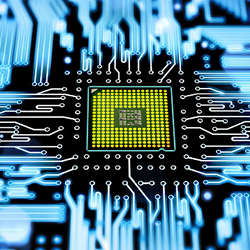
The capabilities of today’s computers and electronic devices are nothing less than astounding. These systems accomplish tasks that extend far beyond the reach of the human mind. Yet, despite increasingly sophisticated functionality and features, silicon-based systems are only as good as their internal circuitry; one bad microchip or damaged internal component, and they are rendered completely useless.
It is a problem that has not eluded scientists and researchers. "Just as human skin and the human body can repair itself, it would be useful to have electronic systems that can detect internal damage and use self-healing capabilities and regain full functionality," says Guihua Yu, assistant professor of materials science and engineering at the University of Texas at Austin. "Introducing materials that can help a damaged device regain functionality could dramatically change the way we think about and use devices."
Already, researchers are exploring how to design and build systems that detect when a component is broken and, using a microcapsule or gel, release a chemical composite that puts the system back into working order. Chao Wang, assistant professor of chemistry at the University of California, Riverside, says self-healing systems have potential in a wide array of areas, including flexible electronics, wearables, biosensors, and batteries. They could eventually have an impact on everything from smartphones and wearables to medical devices and consumer electronics.
Broken Promises
Around 2001, researchers began exploring how to apply self-healing to machines, vehicle and airplane bodies, and an array of other things, explains Scott White, professor of aerospace engineering and head of the Autonomous Materials Systems Group at the Beckman Institute at the University of Illinois, Urbana-Champaign. A decade later, scientists began to focus on electronic components. "In many cases, there’s no way to go inside a device, such as a microchip or battery, and repair it. The goal is to automatically heal conductive pathways and reestablish the flow of electrons through the component," White says.
White’s research has focused on restoring electrical conductivity to cracked and broken circuits. In 2011, a group at the university developed a self-healing polymer that could be placed inside a microcapsule as small as 10 microns. As a crack occurs, the microcapsule ruptures and releases a liquid metal compound. The material fills the gap in the circuitry and, as a result, electrical flow resumes–thus eliminating the need for a structural or mechanical repair. The team reported 90% of the samples tested healed to 99% of original conductivity.
More recently, White has explored the use of encapsulated media, including carbon black and carbon nanotubes, along with an array of conductive agents. Meanwhile, Yu and his colleagues at the University of Texas at Austin have developed a self-healing "super gel" that has both mechanical and electrical self-healing properties. While most systems rely on heat, pressure, or light to induce the self-healing process when a repair needs to take place, this polymer hydrogel can identify a problem without any external stimuli.
"We found that there is a very special group of materials called supramolecular materials that use molecular building blocks interacting with one another via non-covalent interactions. When they are used with conducting polymers, they can engage in reversible chemical bonding and allow self-healing to take place multiple times," Yu says.
Finally, Wang has developed an ambient repeatable self-healing electronic composite material that can be used to sense mechanical forces. His work, along with that of Zhenan Bao, a Stanford University professor of chemical engineering and materials science and engineering, has led to a self-healing skin that may one day be used to build sensors, batteries, solar cells, and other electronic conductors and circuits that can respond like human skin or tissue to damage by initiating the repair process.
The Fix is In
As chemists, engineers, and software developers continue to poke, prod, and experiment with various compounds and approaches, the march toward viable self-healing technology is rapidly moving from the research lab into reality. Although there is no way to build a device that lasts forever, building better internal circuitries and systems could improve everything from smartphones to military and medical technology. In some cases, the healing process might occur instantly–White’s system has already achieved this result–but in others it could take hours or days. This might mandate the need for LED lights or other mechanisms for detecting when the repair is complete and the device is working again, Wang says.
Researchers say within a decade, self-healing electronic components should begin to appear in devices. Yu believes success is rooted in three key factors: developing compounds that are cost-effective on a massive commercial scale; optimizing and customizing materials to work in specific situations and systems, and building self-healing components that continue to function effectively over multiple events or repair cycles. Says White: "The vision is to develop electronics that operate at 100% efficiency for their intended service life and then degrade and recycle themselves. At that point, you can regenerate the electronic component into a new device."
Samuel Greengard is an author and journalist based in West Linn, OR.



Join the Discussion (0)
Become a Member or Sign In to Post a Comment